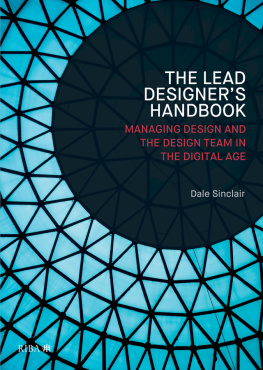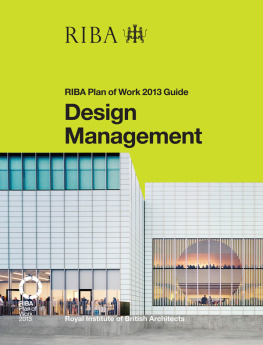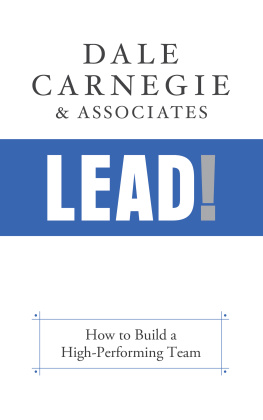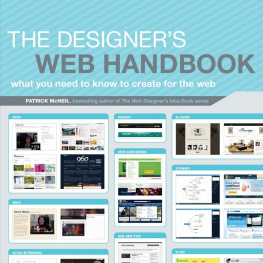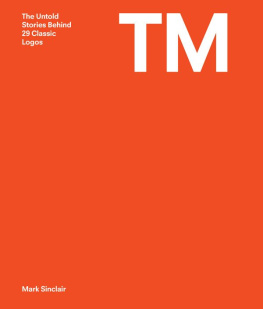Dale Sinclair - Lead Designers Handbook
Here you can read online Dale Sinclair - Lead Designers Handbook full text of the book (entire story) in english for free. Download pdf and epub, get meaning, cover and reviews about this ebook. year: 2019, publisher: RIBA Publishing, genre: Business. Description of the work, (preface) as well as reviews are available. Best literature library LitArk.com created for fans of good reading and offers a wide selection of genres:
Romance novel
Science fiction
Adventure
Detective
Science
History
Home and family
Prose
Art
Politics
Computer
Non-fiction
Religion
Business
Children
Humor
Choose a favorite category and find really read worthwhile books. Enjoy immersion in the world of imagination, feel the emotions of the characters or learn something new for yourself, make an fascinating discovery.
- Book:Lead Designers Handbook
- Author:
- Publisher:RIBA Publishing
- Genre:
- Year:2019
- Rating:4 / 5
- Favourites:Add to favourites
- Your mark:
- 80
- 1
- 2
- 3
- 4
- 5
Lead Designers Handbook: summary, description and annotation
We offer to read an annotation, description, summary or preface (depends on what the author of the book "Lead Designers Handbook" wrote himself). If you haven't found the necessary information about the book — write in the comments, we will try to find it.
Lead Designers Handbook — read online for free the complete book (whole text) full work
Below is the text of the book, divided by pages. System saving the place of the last page read, allows you to conveniently read the book "Lead Designers Handbook" online for free, without having to search again every time where you left off. Put a bookmark, and you can go to the page where you finished reading at any time.
Font size:
Interval:
Bookmark:

Managing Design and the Design Team in the Digital Age
Dale Sinclair
RIBA  Publishing
Publishing
RIIBA Publishing, 2019
Published by RIBA Publishing, 66 Portland Place, London, W1B 1NT
ISBN 978-1-85946-709-1
978-1-85946-742-8 (PDF)
The right of Dale Sinclair to be identified as the Author of this Work has been asserted in accordance with the Copyright, Designs and Patents Act 1988 sections 77 and 78.
All rights reserved. No part of this publication may be reproduced, stored in a retrieval system, or transmitted, in any form or by any means, electronic, mechanical, photocopying, recording or otherwise, without prior permission of the copyright owner.
British Library Cataloguing-in-Publication Data
A catalogue record for this book is available from the British Library.
Commissioning Editor: Elizabeth Webster
Production: Jane Rogers
Designed and typeset by Full Point Creative Media Ltd
Printed and bound by Page Bros, Norwich
Cover Image: Shutterstock.com
Image Credits: All Dale Sinclair or RIBA except; p94 Nex Architects; p95 David Millar
Architects; p96 Coffey Architects; p97 ScottWhitby Studio; p252 AECOM
While every effort has been made to check the accuracy and quality of the information given in this publication, neither the Author nor the Publisher accept any responsibility for the subsequent use of this information, for any errors or omissions that it may contain, or for any misunderstandings arising from it.
www.ribapublishing.com

Leading the Team: An Architects Guide to Design Management (2011) was written to bring clarity to the process of designing a building. It seemed to me that the majority of an architects intellectual effort was spent getting the design right with less emphasis placed on the design process and delivering designs on time and cost, yet clients were wrestling with how to resolve these crucial topics.
Today, the status quo remains. The diversity of projects unveiled at the various RIBA award ceremonies underlines the architectural professions ability to deliver great designs. However, while designers show enthusiasm for digital tools that will deliver new types of geometries or ways of ideating, they continue to be ambivalent about innovating the design process and delivering projects more efficiently and effectively. Indeed, many seem resistant to change that should be business as usual from a client perspective. This publication argues that the breadth and depth of digital disruption will be significant, creating the opportunity to provide transformative design processes that will deliver these great designs in profoundly different ways.
In the meantime, clients and project managers have melded procurement to achieve better outcomes, including delivering projects on time and to cost, as part of new delivery ecosystems. Within these, contractors have successfully tackled BIM (Building Information Modelling) and asset-focused deliverables, becoming more adept at managing the design team during the later design stages, de-risking design and ensuring that the right information is available at the right time for construction. By stepping away from shaping how project processes wrap round the design process, the architectural profession no longer leads the project team, allowing the reverse to occur: on many projects the essence of design has been forgotten, with design shoehorned into project management and procurement processes.
To address these points, this publication is written specifically to consider the role of the lead designer. If architects want to demonstrate that they can design and deliver, they need to champion and revitalise this crucial project role. In recent years the importance of the role has been diluted, for which there are a number of reasons. In part, it is due to new BIM roles emerging such as the BIM manager or information manager that create confusion regarding the project team structure. It is also due to the increased professionalism of client bodies and the greater involvement of project managers and the drive to reshape procurement.
The architect and lead designer roles are predominately commissioned and considered together. Different practices undertake these roles in different ways and there has always been tension between those experienced in delivering projects who have the first-hand knowledge of how buildings are delivered and constructed, and who would tend to undertake the lead designer role and the cohort of architects pushing the boundaries of design with new forms, materials, environmental approaches or the ideas that will lead to new paradigms. Interestingly, clients are more aware of this design and delivery balance than the architectural profession, and are rightly or wrongly able to pigeonhole a practices ability to do one or the other or both. What this does underline is the urgent need for the profession to have a more detailed conversation on the boundaries between these two crucial topics and the need for delivery innovation to catch up with design innovation.
Amid these challenges, a new wave of construction technologies is upon us, varying from straightforward and practical designing for manufacturing initiatives to the complexities of new technologies that will allow the mass customisation of buildings. To avoid locking traditional construction techniques into our designs, the lead designer needs to facilitate early conversations around new ways of making buildings and the profession needs to be more proactive in framing these.
While there is a comprehensive body of research into design methodology, the reverse is true for delivery processes that support the lead designer, and due to this lack of research many of the views in this publication are my own, based on 30 years of undertaking the lead designer role. A core threat to the lead designer is the way that BIM is being shaped. Rather than radically transforming the design process, BIM tools are being absorbed into traditional design processes focused around the comfort of traditional deliverables, albeit with new data deliverables plugged in. If we are to move to faster, smarter and better design processes, we must consign traditional ways of designing to the bin, using digital tools to reshape the design process and how it engages with project processes and procurement. As part of this, it is crucial that the profession begins a conversation around the balance of good design and great delivery If the architectural profession continues to propagate and advocate design processes geared to one-off buildings and fails to address the varied quality of information delivered for tendering and construction, it will find that others will do so.
The two most frustrating aspects of my career have been the challenges of passing on knowledge to the next generation our intuitive ways of working impeding this goal and the persistence of design trumping delivery. This book is not about how to design or how to tackle the complexities of the planning process. It is about giving those undertaking the lead designer role the means of delivering designs on time and to cost while maintaining a tradition of great designs. Importantly, the book redefines the lead designer role for the digital age, moving beyond 2D into the world of 3D: intelligent data-centric design processes with greater real-time integration of analysis tools that face new game-changing ways of making buildings.
Font size:
Interval:
Bookmark:
Similar books «Lead Designers Handbook»
Look at similar books to Lead Designers Handbook. We have selected literature similar in name and meaning in the hope of providing readers with more options to find new, interesting, not yet read works.
Discussion, reviews of the book Lead Designers Handbook and just readers' own opinions. Leave your comments, write what you think about the work, its meaning or the main characters. Specify what exactly you liked and what you didn't like, and why you think so.

